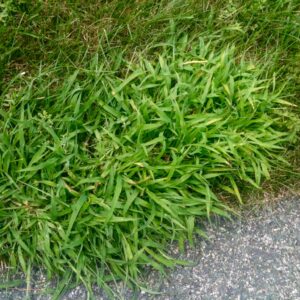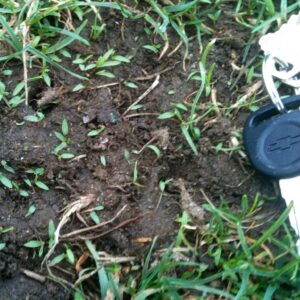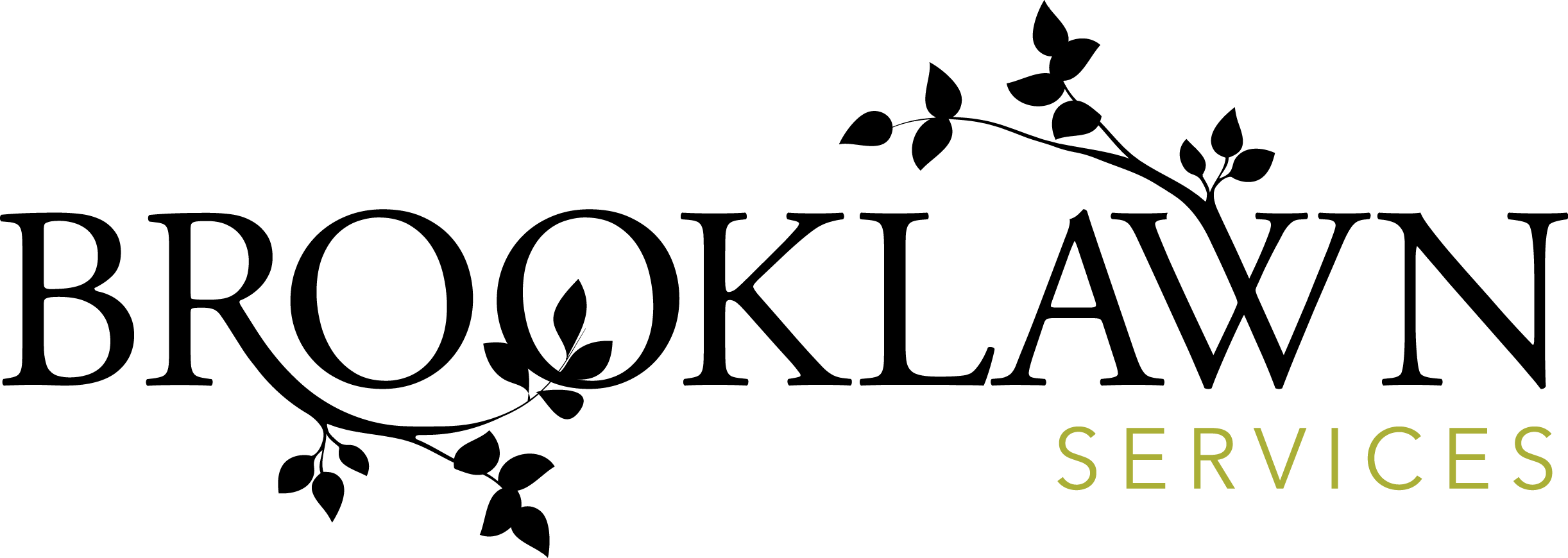If all Indiana homeowners had one common enemy, it’d be crabgrass! With spindly leaves that look like spider legs and an appearance that can be recognized a mile away, crabgrass is one of the most frustrating weeds in Central Indiana yards. But if you believe crabgrass is hiding within your beautiful turfgrass, we’re here to help. Read our comprehensive guide to identifying crabgrass in your Midwest lawn and preventing it in the future.
What Is Crabgrass?
Crabgrass is a hardy, leafy weed found worldwide, including in Africa, Asia, and its native continent, Europe. Of course, crabgrass also made its way to the United States. In Indiana, crabgrass starts appearing around mid-May and takes off in the summer. In Indiana’s growing zones 5B and 6A, you’ll encounter two common species: large and smooth crabgrass. Both have identifying characteristics that can make spotting the crabgrass easier for homeowners.
Where Does Crabgrass Grow?
 Crabgrass is happy to grow nearly anywhere! So, you might find it creeping up in the cracks of your sidewalks and driveways. While many plants can’t survive such infertile areas, crabgrass is drought tolerant and will prosper in sandy soils with lots of light. Since crabgrass can survive in nearly every lawn situation, you might notice an influx of pesky weed growth if your lawn is sick. Crabgrass will grow where the lawn is thinnest, so if your turf is weak or has bare patches, it will sprout and replace the bare spots. Over time, crabgrass can choke out your unhappy lawn completely. So, ensure you’re keeping up with regular maintenance to give your grass some resistance.
Crabgrass is happy to grow nearly anywhere! So, you might find it creeping up in the cracks of your sidewalks and driveways. While many plants can’t survive such infertile areas, crabgrass is drought tolerant and will prosper in sandy soils with lots of light. Since crabgrass can survive in nearly every lawn situation, you might notice an influx of pesky weed growth if your lawn is sick. Crabgrass will grow where the lawn is thinnest, so if your turf is weak or has bare patches, it will sprout and replace the bare spots. Over time, crabgrass can choke out your unhappy lawn completely. So, ensure you’re keeping up with regular maintenance to give your grass some resistance.
What Does Crabgrass Look Like?
Once you ID crabgrass, you’ll be able to recognize it like a pro! But if this is your first time identifying the weed, there are several characteristics to look out for:
- Wide leaf blades. Crabgrass blades are thick, flat, and wide. They also have large veins that run length-wise to the blades, making them noticeably different from regular grass. While they might look similar to many turf varieties, the blades will grow outwards and resemble crab or spider legs.
- Early plants are lime green. Young crabgrass stands out from deeper-colored turfgrass varieties because of its bright green hue. As the plant matures, it becomes a darker and less noticeable green.
- Rapid growth. Within 30 days, crabgrass can grow impressively fast to six inches! Compared to standard lawns, which grow on average an inch per week, crabgrass will emerge and spread noticeably faster.
- Large crabgrass. As the most widespread Indiana weed, you’ll likely encounter large crabgrass at some point. You can identify the crabgrass type by the hairs along the grass blades and sheath.
- Smooth crabgrass. If you have smooth crabgrass, you can identify it by its hairless stems and leaves.
Practical Tips For Identifying Crabgrass
 Identifying crabgrass by its appearance can be helpful. But if you’re looking for additional ID-ing help, you have plenty of options. For accurate identification and more information about the crabgrass type in your lawn, use a free plant identification app like PictureThis. The software allows you to upload a photo of a plant and match it to the most likely plant species. Plus, you’ll receive additional insight into its native habitat, optimal environment, lifespan, and toxicity level.
Identifying crabgrass by its appearance can be helpful. But if you’re looking for additional ID-ing help, you have plenty of options. For accurate identification and more information about the crabgrass type in your lawn, use a free plant identification app like PictureThis. The software allows you to upload a photo of a plant and match it to the most likely plant species. Plus, you’ll receive additional insight into its native habitat, optimal environment, lifespan, and toxicity level.
For a more old-school solution, you can use local plant identification books to confirm whether that mystery weed is really crabgrass or something entirely different. These books usually contain high-quality images and accurate descriptions written by experts for beginners. Some guidebooks may also contain integrated management strategies for eliminating crabgrass from your lawn.
Call a professional for larger crabgrass takeovers that need close inspection. Lawn care technicians handle crabgrass infestations every day in the spring and summer and can easily determine your mystery weed. Plus, their local knowledge can give you better direction in finding a crabgrass solution.
Watch Out For These Lookalike Plants
Indiana weeds are especially irritating because they can look like other plants, making them difficult to identify. Crabgrass, particularly, loves to disguise itself within plants you wouldn’t want to pull or spray. So before eliminating crabgrass with weed killers, make sure the weed isn’t one of these other common Indiana plants.
- As the most popular Indiana turfgrass choice, bluegrass can easily be mistaken for crabgrass. Of course, you don’t want to uproot or spray your precious lawn accidentally! So look out for the unique dark green color bluegrass will have compared to its brighter green counterpart, crabgrass.
- This vibrant green grass type also gets mistaken for crabgrass. However, quackgrass is also regarded as a weed. Unfortunately, there isn’t a quackgrass-specific solution that will eliminate it like a broadleaf herbicide, so it needs special attention from a lawn care expert.
- Like crabgrass, nutsedge is notorious for spreading quickly and aggressively. However, it grows upright instead of growing out wide (prostrate) like crabgrass. If you’re dealing with a case of nutsedge, we recommend a pre-emergent herbicide application in the spring to stop its growth at the source.
How To Prevent Crabgrass in IN
All homeowners can agree that crabgrass is a pain. If you’ve determined that the mystery weed in your Central Indiana lawn is, in fact, crabgrass, don’t panic! Here are three steps to stop crabgrass once and for all:
- Apply a pre-emergent herbicide to your lawn in the spring. This will kill most Indiana weed seeds and prevent them from ever germinating.
- Mow at a higher height. We recommend setting your mower to a height of around 3.5 inches, improving the lawn’s density and stopping invasive weeds from growing in.
- Spot seed any bare patches in your lawn. If you’ve dealt with past lawn damage, fill in empty soil patches as soon as possible. Crabgrass quickly finds opportunities to invade bare spots, so ensure you beat crabgrass to the punch!
Conquer Crabgrass In Your Central Indiana Lawn Today
Kick crabgrass to the curb! At Brooklawn Services, we don’t tolerate crabgrass in our customers’ lawns. So, let us handle the hassle with pre-emergent herbicide solutions this spring. Get in touch with our Muncie and Indianapolis offices at 888.794.9555. We look forward to reviving your lawn with care!


